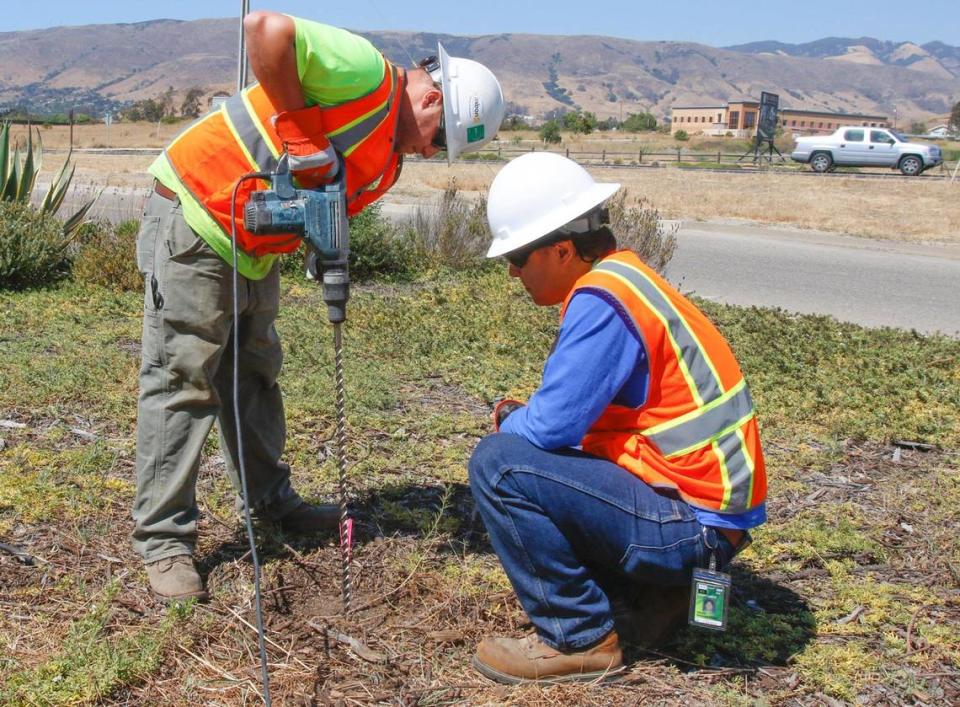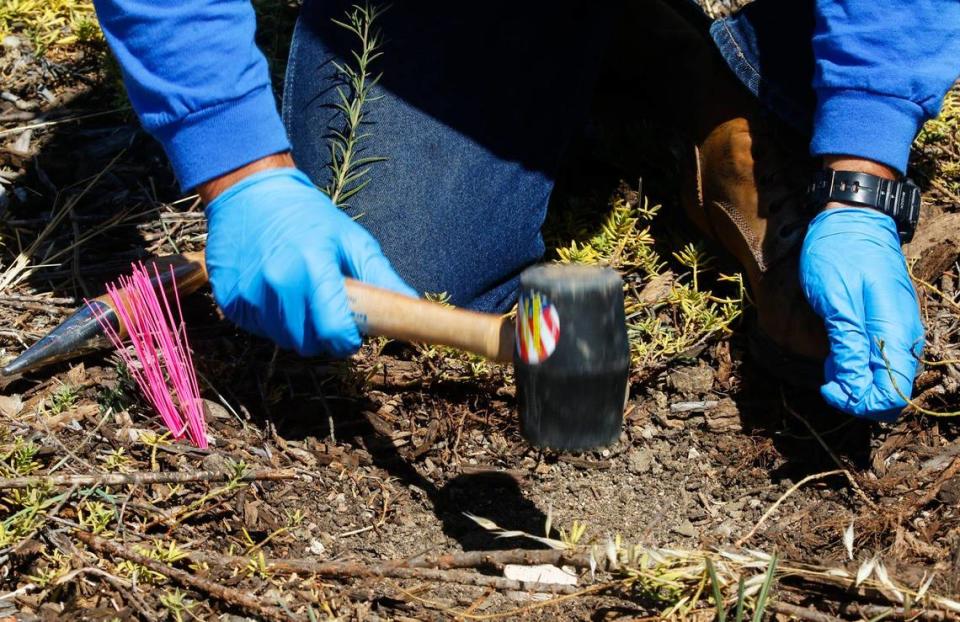Water board finds new culprit for cancer-causing chemical released in SLO. What’s next?
It has been nearly three years since water regulators told the Noll family that they were guilty of polluting the water beneath their San Luis Obispo neighborhood with a cancer-causing chemical.
The San Luis Obispo County Public Health Department issued a notice on Christmas Eve 2015 that trichloroethylene, or TCE, had been discharged into the groundwater in the small rural neighborhood south of San Luis Obispo County Regional Airport far above safe levels.
Those who had been drinking and showering in the contaminated water were at higher risk of liver or kidney damage and cancer, the notice said.
In January 2020, the Central Coast Regional Water Quality Control Board issued the Nolls — who rent out a few buildings at 4665 Thread Lane — a cleanup and abatement order to remediate the chemical pollution.
The board believed TCE had been dumped on the Nolls’ property decades ago and made its way into the drinking water wells of 13 properties near the intersection of Noll and Buckley roads.
Since then, Janice Noll and her brother, John, have been paying more than $50,000 every year to maintain water filters on the wells to keep their neighbors from being exposed to TCE.
But now there’s a new suspected culprit.

Who is responsible for chemical pollution in SLO?
On April 13, the regional water board issued a draft cleanup and abatement order to the owners of a property at 795 Buckley Road, saying that they had been a likely source of the TCE pollution all along.
The owners of that property include John Coakley of Coakley Vineyards, James Michael Sims of Pacific GeoScience, Janine Garfinkel and Annette Terry.
“According to newer 2022 investigation data for 795 Buckley Road, the distribution of TCE in soil gas and groundwater indicate that the septic system (possibly the septic tank) at 795 Buckley Road is a source of solvent and petroleum chemical discharge to groundwater in the Buckley Road area,” the water board’s draft cleanup and abatement order says.
As much as 560 micrograms per liter of TCE were found in the soil and 2,000 micrograms per liter in the groundwater under the property, according to water board reports.
The maximum amount of TCE allowed in drinking water in California is 5 micrograms per liter, with a goal of 1.7 micrograms per liter for tap water to avoid health impacts, according to the state’s Office of Environmental Health Hazard Assessment.
Once the final cleanup and abatement order is issued, the owners of 795 Buckley Road must submit a plan to clean and replace the contaminated water for the neighborhood.
They must also figure out how to remediate the site so the TCE pollution at the property does not continue to pollute the soil and groundwater.
The order will not be officially issued until after May 15, however, giving the property owners and the public time to submit any written comments about the draft.
The owners of the property at 795 Buckley Road did not respond to requests for comment from The Tribune.
Contamination found more than 2 decades ago
TCE pollution was first detected in the Buckley Road area in the late 1990s when county environmental health officials sampled local residents’ wells and found unsafe levels of the chemical in the water.
In 1998, the water board sent a letter to John Noll and others alerting him that a neighbor at 795 Buckley Road had found his groundwater well was contaminated with the chemical.
The news came as a shock to Noll, who operated a company on the property at the time that made medical devices from stainless steel.
“The problem with the TCE contamination is of great concern and confusion,” Noll wrote in a February 1998 letter to the water board. “Until I received your letter, I have never even heard of TCE.”
Noll told water board officials that he had conducted an internet search and found that “TCE is not something that is used in this business or in this industry.”
In the same letter, Noll told water board officials his concern that his neighbor at 795 Buckley Road had a fire on his property in the late 1970s.
Noll suspected that chemicals likely stored on the property had gotten released into the ground, he wrote in the letter.
Noll was correct about the fire but not the date.
In 1981, a fire burned down an entire structure at 795 Buckley Road. Firefighters dumped enough water on the flames to wet a good portion of the property, news reports said at the time.

Public health notice kicks off hunt for TCE source
Over the following years, wells in the neighborhood were regularly monitored to keep an eye on the TCE contamination.
However, it wasn’t until Public Health sent out its notice on Christmas Eve in 2015 that efforts to clean up the pollution began in earnest.
By then, it was apparent the TCE contamination wasn’t just under the property at 795 Buckley Road, but under the entire neighborhood.
In total, 14 water wells were contaminated with unhealthy levels of the carcinogen.
Thirteen of those wells fed directly into homes and businesses, with water used for drinking, showering and washing hands. Another well was used in industrial operations.
“Affected well owners whose water well exceeds (5 micrograms per liter) for TCE are advised to use bottled water for drinking and cooking and to install an activated carbon shower head filter, until they install a water treatment system to reduce the TCE concentration,” the public health department’s 2015 notice said.
Studies indicate that TCE causes kidney and liver damage and increased the risk of cancer. It may also cause developmental effects such as spontaneous abortion, congenital heart defects, central nervous system defects and low birth weight.
The Public Health Department’s notice kicked off a thorough investigation by the water board to track down the source of the TCE contamination.
Buckley Road area sites tested to find source
The water regulators began with three sites where the highest levels of TCE contamination had been found in the past: two Buckley Road properties and the Nolls’ property on Thread Lane.
Investigations there weren’t fruitful, so the water board decided to look at the airport, where TCE could have been used to clean airport equipment.
No clear source of TCE was found there, so the water board retraced its steps and decided to conduct more thorough investigations of the Buckley Road and Thread Lane properties.
The Nolls protested and hired an attorney to send the water board a strongly worded letter asserting that their property was not the culprit because they had no strong evidence that TCE was ever used there.
Instead, the Nolls pointed the finger at 795 Buckley Road.
“From at least the early 1970s until approximately 1982, (795 Buckley Road) was occupied by a firm called Central Coast Labs,” attorney David Ossentjuk wrote in his January 2017 letter to the water board. “Central Coast Labs conducted asphalt testing at that facility from the 1970s (and possibly earlier) to early 1980s. It used TCE in those testing processes, and large quantities of TCE were stored and on the ... property during that time frame.”
However, documents submitted to the water regulators in 1998 show a solvent, trichloroethane, or TCA, was used on the Nolls’ property.
TCA was commonly used as a replacement for TCE because it was less toxic, indicating that TCE might have been used before the record-keeping of chemicals used on the property began.
Cleanup order issued to suspected TCE source in 2020
By 2019, results from the investigations of the three properties suggested the groundwater under the Nolls’ property contained the highest levels of TCE at the time.
“Results from the soil and soil vapor investigation did not indicate a clear source of TCE,” the water board said in a public notice issued in January 2019. “However, TCE was detected at elevated concentrations in deep groundwater beneath the 4665 Thread Lane property at a concentration of 783 micrograms per liter.”
That level of TCE is about 157 times greater than the drinking water standard, 13 times higher than the highest domestic supply well concentration, and over two times higher than the highest historical concentration of TCE reported for an industrial supply well located at 795 Buckley Road, according to the water board.
The water board issued a draft cleanup and abatement order later that year to the Nolls and other owners of the property at 4665 Thread Lane.
The Nolls again protested, asserting they were not the source of the pollution — but the water board insisted there was no clear evidence the pollution was coming from elsewhere.
The final cleanup and abatement order was issued to the Nolls in January 2020.
Since then, they have spent tens of thousands of dollars installing water filters on their neighbors’ wells to ensure the water going into the homes and businesses wasn’t contaminated with TCE.
“You just feel like you’re a criminal,” Janice Noll said. “We’ve been looked at as if we were the ones who put the TCE in the soil and we aren’t.”
New airport investigation reveals TCE source could be elsewhere
Rewind to late 2019, the water board requested that San Luis Obispo County take another look at the airport to see if any TCE contamination sources could be found at an old aircraft hangar that was on the site for a limited amount of time.
The investigation’s results, released in December 2020, found that the highest levels of TCE didn’t come from the airport property, but from a spot on the edge of 795 Buckley Road.
That led to the water board requesting a further investigation of 795 Buckley Road.
That investigation, which concluded in November 2022 and tested new areas of the property, revealed high levels of TCE in the soil and groundwater under 795 Buckley Road.
In its draft cleanup and abatement order issued to the owner of 795 Buckley Road in April, the water board notes the confusion, saying it originally held “an interpretation that the well serving the 795 Buckley Road property was capturing TCE in groundwater from beneath the 4665 Thread Lane property.”
However, the 2022 investigation revealed that interpretation could be wrong and the source of the TCE pollution was likely at 795 Buckley Road, where the old asphalt testing laboratory had used TCE.
A recent test in late 2022, after the investigation was released, found up to 2,000 micrograms per liter of TCE in the groundwater at 795 Buckley Road, far above the 783 micrograms per liter of TCE found in the Nolls’ property groundwater.
“Site investigation data collected from the 795 Buckley Road property in 2021 and 2022, show that TCE and related chemicals appear to have migrated to 4665 Thread Lane from a source area at 795 Buckley Road,” the water board’s April 13 draft cleanup and abatement order said.
The water board is accepting comments on the draft order through May 15.
The Nolls, in the meantime, have requested the water board rescind the cleanup and abatement order issued to them in 2020.
“The Central Coast Water Board ... has solicited public comment on this potential rescission during a public comment period for 795 Buckley Road,” Greg Bishop, senior engineering geologist and site cleanup manager for the local water board, wrote in an email to The Tribune. “A decision about rescinding that order will be made after public comments are considered.”
“The Central Coast Water Board has not yet concluded that 4665 Thread Lane is not a source” of the TCE contamination, Bishop added.

